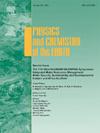Evaluation of the performance of magnetic SiO2/MgFe3O4 nanoparticles as a recyclable demulsifier for the separation of water-in-oil (W/O) emulsions from heavy crude oil
IF 3
3区 地球科学
Q2 GEOSCIENCES, MULTIDISCIPLINARY
引用次数: 0
Abstract
Magnetic silica-based MgFe3O4 nanoparticles were synthesized using the ultrasonic method and employed as a separation agent for water-in-oil (W/O) emulsions in crude oil. This study evaluated the impact of combining these nanoparticles with an industrial demulsifier (V-4654) to enhance water separation efficiency while reducing chemical consumption in the Rumaylah oil field, southern Basra. Structural analysis was conducted using FT-IR, XRD, SEM, and VSM techniques. Response surface methodology (RSM) was used to optimize key parameters, achieving a maximum separation efficiency of 97.23 % under optimal conditions: 45 °C, pH 6.20, 300 ppm demulsifier, 7.25 mL water, and 0.040 g nanoparticles. After three reuse cycles, nanoparticles retained 86 % of their efficiency. Deposition time significantly affected separation, increasing efficiency to 72.50 % after 60 min. Adding nanoparticles alongside the demulsifier after 180 min resulted in a 15.41 % increase in water separation compared to using the demulsifier alone. Increasing the nanomagnetic particle concentration further enhanced separation by 16.38 % and reduced deposition time to 3 h. Results demonstrated that mixing time and stability were significantly lower than in conventional separation methods, highlighting the effectiveness of magnetic nanoparticles in crude oil emulsion treatment.
磁性SiO2/MgFe3O4纳米颗粒作为可回收破乳剂分离重质原油中油包水(W/O)乳状液的性能评价
采用超声法制备了磁性二氧化硅基MgFe3O4纳米颗粒,并将其作为原油中油包水(W/O)乳状液的分离剂。在巴士拉南部的Rumaylah油田,该研究评估了将这些纳米颗粒与工业破乳剂(V-4654)结合使用,在提高水分离效率的同时减少化学品消耗的影响。采用FT-IR、XRD、SEM和VSM技术进行结构分析。采用响应面法(RSM)对关键参数进行优化,在45°C、pH 6.20、300 ppm破乳剂、7.25 mL水和0.040 g纳米颗粒的最佳条件下,分离效率达到97.23%。经过三次循环使用后,纳米粒子的效率保持了86%。沉积时间显著影响分离,60分钟后效率提高到72.50%。180分钟后,与破乳剂一起加入纳米颗粒,与单独使用破乳剂相比,水分离效率提高了15.41%。提高纳米磁性颗粒浓度可使分离效果提高16.38%,并将沉积时间缩短至3 h。结果表明,与常规分离方法相比,混合时间和稳定性显著降低,凸显了纳米磁性颗粒在原油乳状液处理中的有效性。
本文章由计算机程序翻译,如有差异,请以英文原文为准。
求助全文
约1分钟内获得全文
求助全文
来源期刊

Physics and Chemistry of the Earth
地学-地球科学综合
CiteScore
5.40
自引率
2.70%
发文量
176
审稿时长
31.6 weeks
期刊介绍:
Physics and Chemistry of the Earth is an international interdisciplinary journal for the rapid publication of collections of refereed communications in separate thematic issues, either stemming from scientific meetings, or, especially compiled for the occasion. There is no restriction on the length of articles published in the journal. Physics and Chemistry of the Earth incorporates the separate Parts A, B and C which existed until the end of 2001.
Please note: the Editors are unable to consider submissions that are not invited or linked to a thematic issue. Please do not submit unsolicited papers.
The journal covers the following subject areas:
-Solid Earth and Geodesy:
(geology, geochemistry, tectonophysics, seismology, volcanology, palaeomagnetism and rock magnetism, electromagnetism and potential fields, marine and environmental geosciences as well as geodesy).
-Hydrology, Oceans and Atmosphere:
(hydrology and water resources research, engineering and management, oceanography and oceanic chemistry, shelf, sea, lake and river sciences, meteorology and atmospheric sciences incl. chemistry as well as climatology and glaciology).
-Solar-Terrestrial and Planetary Science:
(solar, heliospheric and solar-planetary sciences, geology, geophysics and atmospheric sciences of planets, satellites and small bodies as well as cosmochemistry and exobiology).
 求助内容:
求助内容: 应助结果提醒方式:
应助结果提醒方式:


